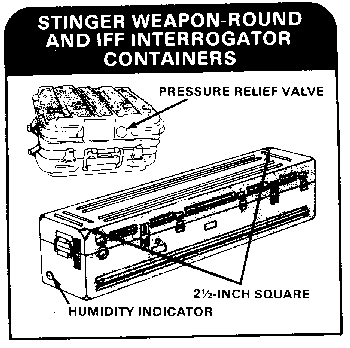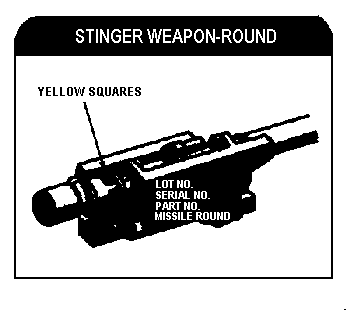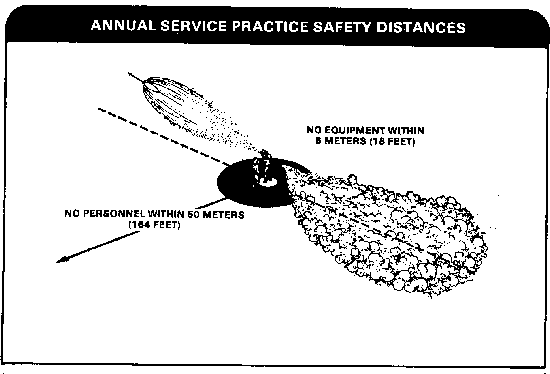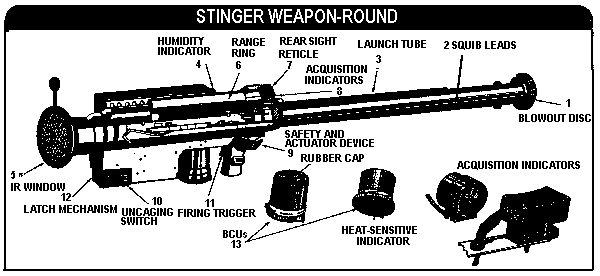CHAPTER 2
Weapon Handling
Upon receipt of a Stinger weapon-round from the ammunition supply point (ASP), it must be checked to be sure it is suitable for firing. The weapon should be removed from the shipping and storage container and inspected in accordance with (IAW) the "services upon receipt" checks, which are found in TM 9-1425-429-12. This manual does not cover preventive maintenance checks and services (PMCS). However, this chapter does contain an abbreviated set of weapon checks which may be made under field conditions when the time and tactical situation permit. Such a time may be at (or near) the ASP or when converting a missile-round to a ready-round. In addition, this chapter describes weapon handling and safety precautions which must be followed by Stinger gunners to prevent injury to personnel and damage to equipment.
STINGER HANDLING PROCEDURES
When the Stinger team first receives a weapon, the markings on the container (case) should be checked to be sure that it contains the proper weapon. Yellow squares, on two diagonally opposite corners on the case and yellow data markings, indicate it contains a live round.
Containers for trainers are marked with blue colored squares for the tracking head trainer (THT) and bronze for the field handling trainer (FHT). In addition, the data markings are white and these containers have the word "INERT" on the top of the case.
The Stinger weapon-round and IFF interrogator containers are sealed to prevent environmental damage. Before either case is opened, the pressure relief valve should be pressed with the finger. When the rushing noise (if any) stops, the internal pressure of the case is the same as the pressure outside the case. The missile-round container does not have a pressure relief valve.
|
CONTENTS |

When out of its container, the weapon should be rested carefully on its side. Do not stand the weapon on end. Be sure that the launch tube has the proper color markings--four 1-inch yellow squares. If it does not, return the trainer to the ASP and exchange for a weapon-round.

While the gunner is walking, he should carry the weapon by placing the carrying sling over his shoulder. The weapon should be carried horizontally at a slight angle. The sling should be tight enough to prevent the weapon from swinging.
The protective covers (BCU receptacle front-end and IFF connector caps) should not be removed until preparing to fire or while inspecting the weapon.
Stinger equipment and trainer markings are in TM 9-1425-429-12 and TM 9-6920-429-12.
WEAPON CHECKS
When Stinger weapons are issued, and sufficient time is not available to perform all the checks listed in the technical manual, the team chief and gunner must, as a minimum, make the following checks. This does not mean that the other checks listed in TM 9-1425-429-12 should be overlooked, if time permits.
FULL CHECKS
Under field conditions, and if the tactical situation allows, full checks should be made on a daily basis. Checks should be made at times when the team is in a reduced state of alert. These checks are especially important for those weapons which have been outside of their containers and exposed to bad weather. Fu1l checks are found in TM 9-1425-429-12.
Note: Although sunlight normally will not cause damage to the seeker, care should be taken to keep an uncovered seeker pointed away from the sun.
CRITICAL CHECKS
A well-thought-out and organized procedure for checking the Stinger weapon-round will insure that it can be fired when it is needed. If any of the items listed are defective, then the component which it belongs to is considered not ready/available.
MISSILE-ROUND
Missile-round critical checks are as follows (see Stinger Weapon-Round illustration):
If the paint seals on the screws holding the range ring or rear sight reticle to the sight assembly are broken, assume that they have been tampered with and do not use the launch tube until boresight has been verified.
GRIPSTOCK ASSEMBLY
Before doing these checks, check to see if a BCU is installed. If a BCU is installed, do not inspect the gripstock assembly. Do not remove the BCU. The following checks will be done during weapon firing:
BATTERY/COOLANT UNIT
The following are BCU critical checks (check all BCUs 13):
Note: Do not remove an installed BCU to do the following checks.
Note: Weapon mating procedures are outlined in TM 9-1425-429-12.
SAFETY PRECAUTIONS
During annual service practice firing, there should be no personnel closer to a firing point than 50 meters (164 feet). Under combat conditions, personnel within 15 meters (50 feet) of the weapon run a high risk of being injured by flying glass and debris. The team chief should be close to the gunner's side to insure that he is not endangered by the weapon's backblast. Allow at least 5 meters (16 feet) safety distance from equipment. Under combat conditions, these safety distances for personnel and equipment may not always be feasible. Damage to radio equipment may result if it is within the backblast area. Always inform the unit that you are supporting of the noise and backblast safety hazards.
Stinger firing range requirements for surface danger zones are described in (SNF) FM 44-1A.

Additional safety measures to be observed are as follows:
|
WARNING Permanent deafness will result if personnel are exposed to more than two firings. Proper hearing protection must be worn! |

Before inserting the BCU, make certain that the safety and actuator device is in the SAFE position. The Stinger weapon is shipped with a cap covering the BCU receptacle. The cap should be kept in place until just prior to BCU insertion. Remove the receptacle cap by turning it counterclockwise. Place it in the BCU container found in the shipping and storage container for use at another time. You can also place the cap on some convenient location of the body (pocket, inside shirt, etcetera). Insert a BCU into the receptacle and turn it clockwise until it locks in place.
The case of the BCU gets extremely hot (400°F) 3 to 5 minutes after activation and remains too hot to touch for approximately 30 minutes. Do not grab the BCU except by the heat-insulated cap. Remove the BCU immediately after firing.
|
NEWSLETTER
|
| Join the GlobalSecurity.org mailing list |
|
|
|


